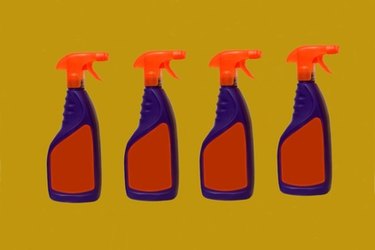
Many modern cleaning products are made from different mixtures of chemicals. Not all chemicals are dangerous, but some can be quite harmful to the body. Most household cleaners are safe if used according to the package directions. If common precautions are taken, such as wearing gloves, working in a ventilated area and not ingesting the cleaning products, there is little reason to fear these chemicals. However, it is important to realize the danger of these chemicals if they are misused.
Bleach
Video of the Day
Bleach is a very dangerous chemical if it is swallowed or splashed onto the skin or in the eyes. Bleach will cause skin rashes and broken skin if poured over skin at 100 percent strength. Bleach can cause blindness if it gets into the eyes and remains untreated. Bleach will also release noxious fumes when mixed with base chemicals, such as ammonia.
Video of the Day
Ammonia
Ammonia is dangerous to the respiratory system. If used in a non-ventilated area, the fumes from ammonia can cause someone to pass out from lack of clean air. The respiratory problems are intensified if ammonia is mixed with an acidic cleaner, such as bleach. Ammonia is also harmful if swallowed.
Lye
Lye is used as an abrasive in many cleaning products such as oven cleaner. Lye is very harmful to the skin and can cause rashes and even remove skin completely. Lye can also cause respiratory problems and should only be used in well-ventilated areas.
Diethanolamine and Triethanolamine
Diethanolamine and triethanolamine are sudsing agents in many all-purpose cleaners that foam or have suds. These agents can bond with nitrites present on the cleaning surface or in the cleaning agent itself. When this occurs they can form nitrosamines, which are possible carcinogens, according to the Organic Consumers Association. This carcinogen can be absorbed into the skin.
Butyl Cellosolve
Butyl cellosolve is a chemical found in some cleaners. This chemical is believed to be a neurotoxin, according to the Organic Consumers Association. A neurotoxin is damaging to the brain and nervous system, and too much exposure can severely damage these parts of the body.
Alkylphenol Ethoxylates
Alkylphenol ethoxylates are used in some detergents and cleaners to help the cleaners work more effectively. Alkylphenol ethoxylates may be hormone disruptors, which can disrupt the normal chemical signals that the brain sends to the body. This can cause a hormone imbalance, such as the production of too much estrogen in the body.
Sulfuric Acid
Sulfuric acid is an abrasive chemical found in many cleaning products, such as rust remover. Sulfuric acid is a corrosive agent, and is used to remove unwanted materials from surfaces. Sulfuric acid can damage the skin and is especially dangerous to sensitive skin.
Sodium Hydroxide
Sodium hydroxide is a corrosive acid that is used in products such as rust remover and drain cleaner. The same properties of the acid that eat away unwanted materials can also damage the skin.